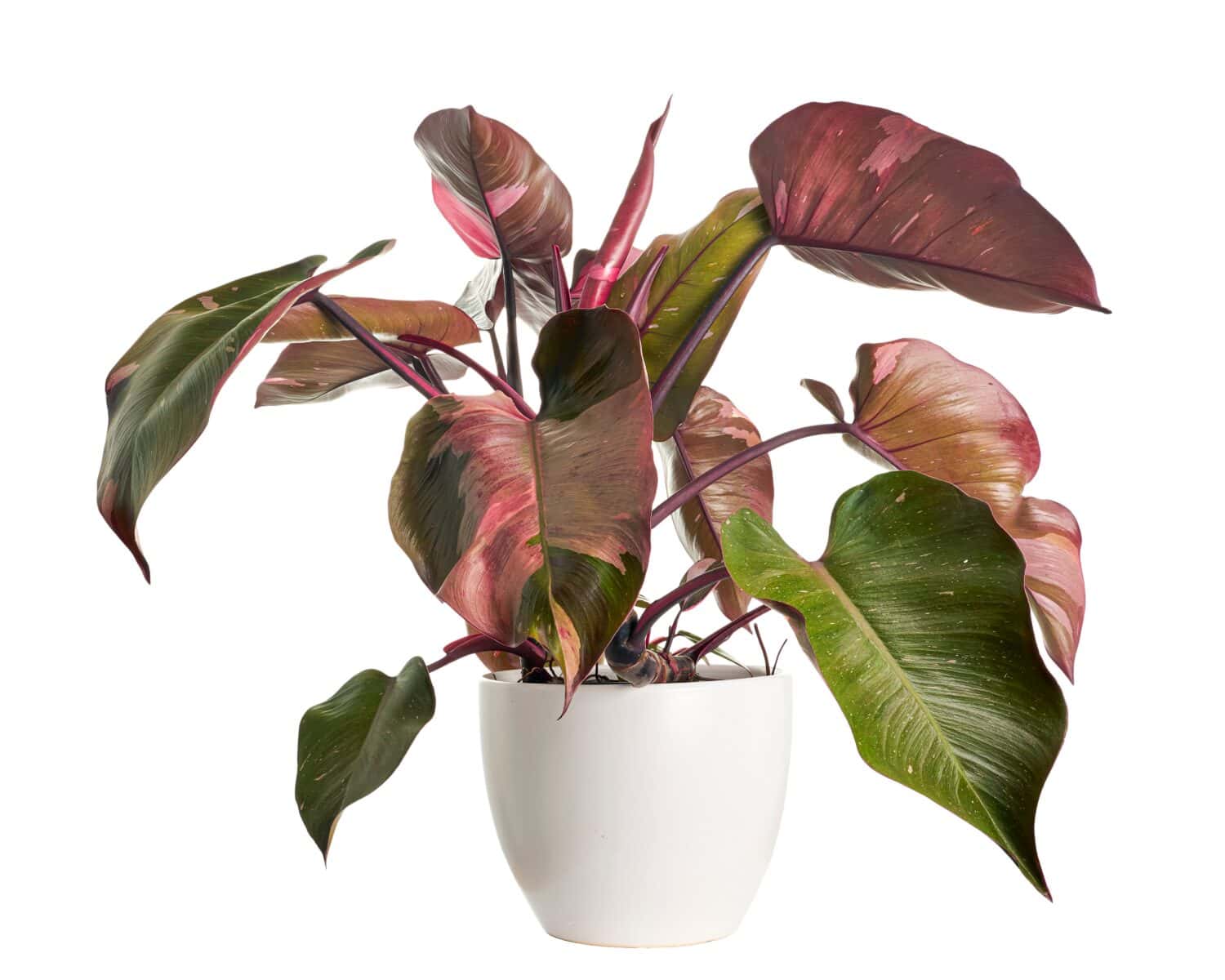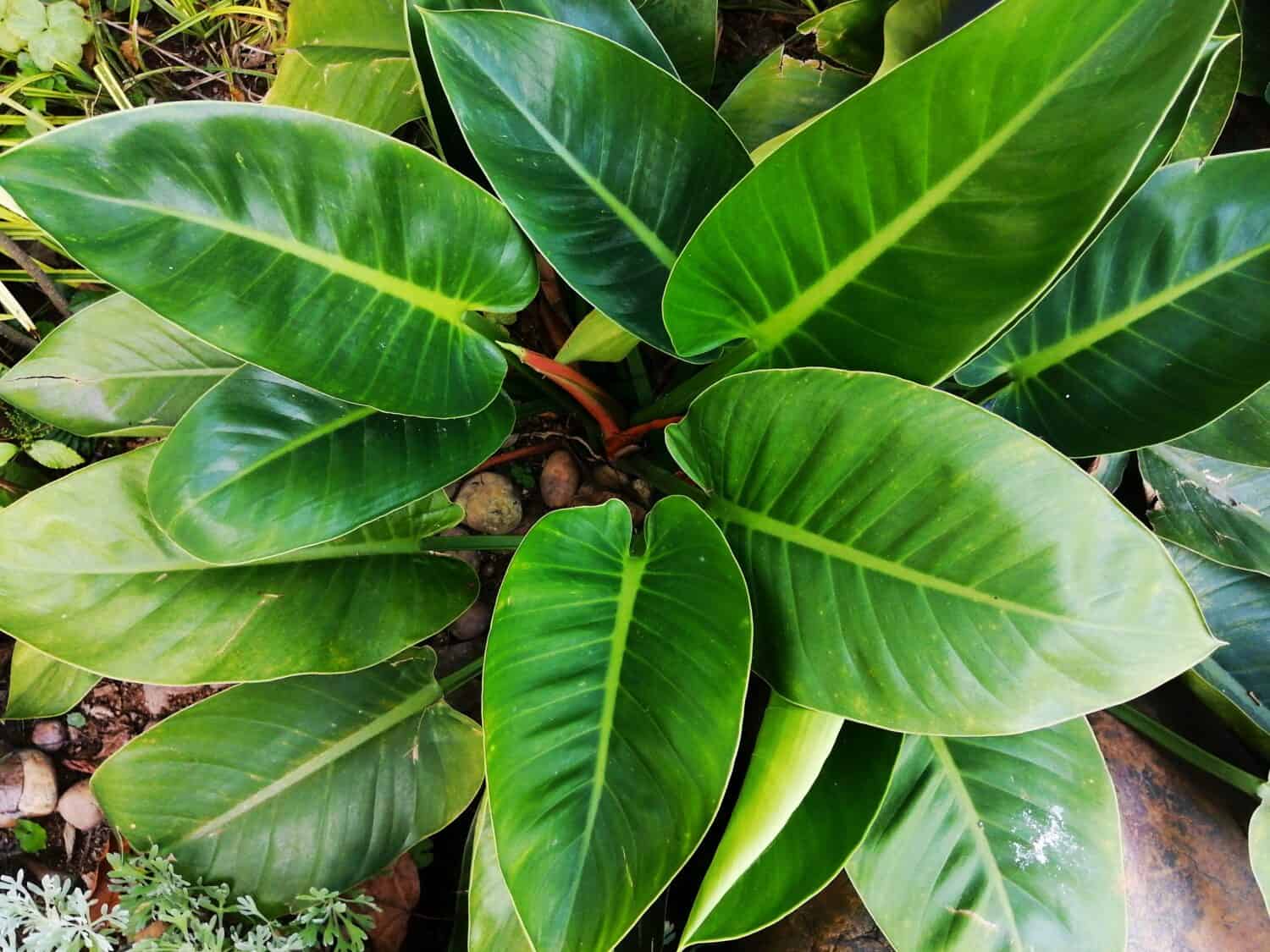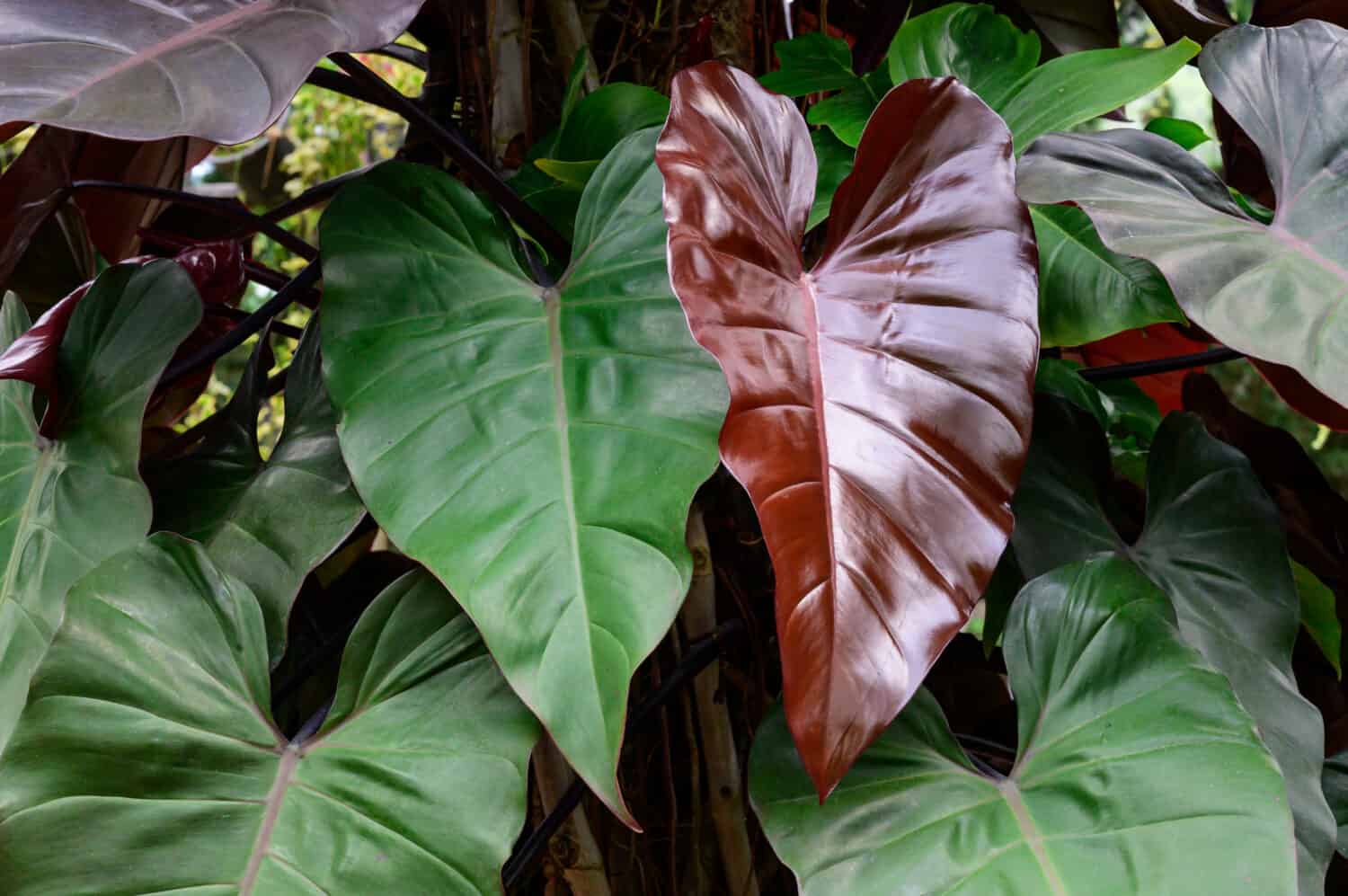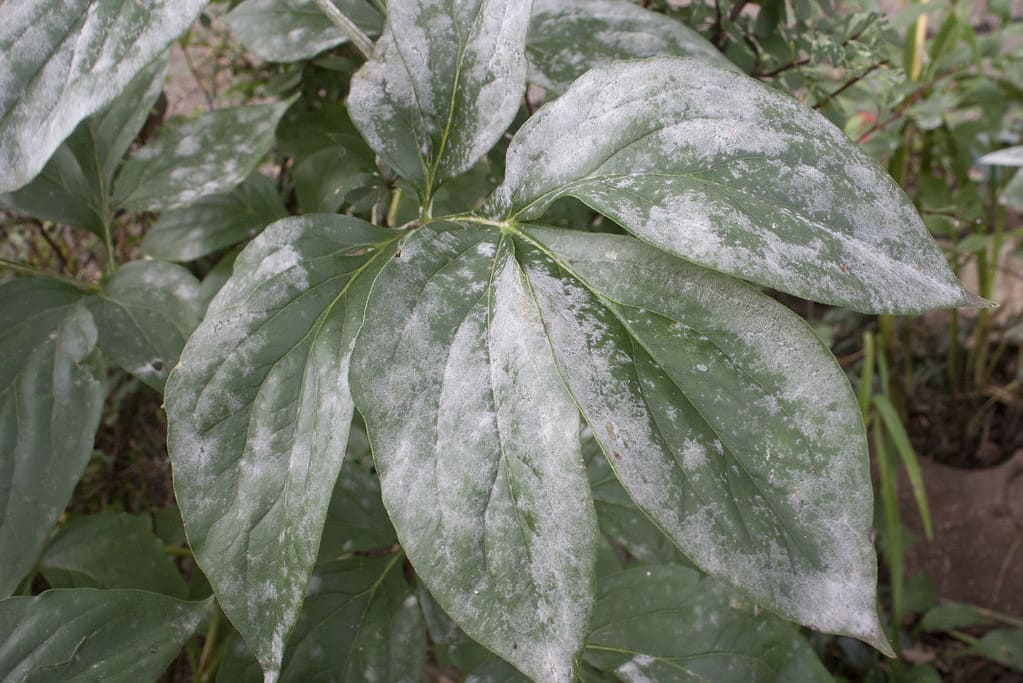Taking care of your Philodendron Erubescens doesn’t have to be a daunting task. With this complete guide, you’ll learn how to ensure the health and vitality of your beloved plant.
About Philodendron Erubescens

Pink Princess is a lovely cultivar of the Philodendron Erubescens.
©Dewin ID/Shutterstock.com
Philodendron Erubescens is a tropical plant native to the jungles of Colombia. These plants have heart-shaped leaves that are dark green and glossy on the top, with a burgundy-red hue at the bottom. In its tropical habitat, it can grow up to 60 feet tall and take on an epiphytic form. Caring for your Philodendron Erubescens is important if you want it to stay healthy. People also call Philodendron Erubescens the red philodendron and blushing philodendron.
The Best Potting Mix for Philodendron Erubescens
When it comes to potting up Philodendron Erubescens, the best potting mix is one that is light, airy, and well-draining. It should contain a good mix of organic matter, such as peat moss, compost, and coarse perlite or vermiculite. To make your own aroid potting mix, start with two parts peat moss, one part compost, and one part perlite or vermiculite. Mix these together and add a slow-release fertilizer to ensure your plant has enough nutrients to thrive.
Once you have your mix ready, make sure to moisten it before potting up your Philodendron Erubescens. This will help the soil to retain moisture and encourage the roots to spread out. Make sure not to over-water your plant, as this can lead to root rot and other issues. Also, don’t forget to provide adequate drainage, as this is essential for keeping the roots healthy.
Ideal Light Conditions

If you can keep the temperature in your home above 60°F, you can grow a tropical Philodendron Erubescens.
©Hanna Yohanna/Shutterstock.com
Philodendron erubescens does best in bright, indirect sunlight. It should be placed in a spot that is away from direct sunlight, such as near a window that receives morning or evening sunlight. The plant can also tolerate low light, but it is not ideal for its health. If you live in the northern hemisphere, the best place to put this plant is 12-36 inches away from an east or west-facing window.
It is important to regulate the amount of light that the plant receives. Too much or too little light can cause the leaves to yellow or wilt. To ensure that the Philodendron Erubescens is receiving the right amount of light, it should be checked regularly.
Watering Your Philodendron Erubescens
Watering your Philodendron Erubescens correctly is essential for its health and beauty. Here are some tips for keeping your houseplant happy and well-hydrated:
- It’s best to water your Philodendron Erubescens in the morning or late afternoon when the sun is not at its hottest.
- Make sure that the soil is evenly moist but not soggy. Check the soil periodically to make sure it isn’t too wet or too dry.
- Root rot is the number one cause of death for this plant. Do not water it on a schedule. Gauge if it needs water by touching the soil rather than by the calendar.
- If you’re not sure if the soil is moist enough, stick your finger about an inch deep. If the soil is dry, water the plant.
- If you’re using tap water, let it sit for a few hours to let the chlorine evaporate.
- If you notice brown patches on the leaves, it could be a sign of underwatering or overwatering. Adjust your watering schedule accordingly.
By following these tips, you’ll be sure to keep your Philodendron Erubescens healthy and looking its best!
Temperature and Humidity

The Philodendron Erubescens loves a warm, tropical atmosphere with high humidity.
©Mid Tran Designer/Shutterstock.com
The ideal temperature range for Philodendron Erubescens grown indoors is between 70-77°F (18-25°C). Keep the humidity between 50-70%, and the plant should be in a spot with plenty of bright, indirect light.
To keep the Philodendron Erubescens in the ideal temperature and humidity range, make sure to keep the soil moist but not overly wet. Additionally, misting the leaves of the plant can help keep the humidity up. If the temperature in the room is too low, try using a heat mat or a humidifier to keep the temperature and humidity at the right level. Finally, keep your Philodendron Erubescens away from any drafts or direct heat sources, as this can damage the plant.
Fertilizing a Philodendron Erubescens
A Philodendron Erubescens is a beautiful houseplant with lush foliage and deep red stems. To keep this plant healthy and growing, it needs to be fertilized regularly.
- Use a balanced fertilizer such as a 20-20-20 or 10-10-10.
- Dilute the fertilizer to half-strength before applying it to the soil.
- Feed the plant every four weeks during the growing season.
- During the winter, stop feeding and let the plant go dormant.
- Make sure the soil is damp when fertilizing so the plant can better take the nutrients up into its tissues.
Propagation
Propagating Philodendron erubescens through stem cuttings is a simple and straightforward process that can quickly increase your plant collection. The process involves taking a stem cutting from an existing plant, allowing the cutting to form new roots, and then repotting it separately.
To begin, you’ll need a few supplies: pruning shears, a glass of water, and a pot of soil. First, use the pruning shears to cut a stem from the existing plant, making sure it is at least 4-5 inches long with two or three nodes. Then, place the cutting in the glass of water and allow it to sit until new growth appears. This can take up to a month.
When the cutting is ready, you will see fresh white roots. Fill a small pot with soil, making sure the soil is well-draining. Then, make a hole in the soil about four to five inches deep and gently place the cutting into the hole. Be sure to bury the rooted end of the cutting firmly. Finally, water the soil and keep it moist until the plant starts forming new leaves.
How to Prune a Philodendron Erubescens

If your Philodendron Erubescens becomes too large, you can prune it and propagate the cuttings.
©Tonio_75/Shutterstock.com
Prune a Philodendron Erubescens if it begins to look leggy or large, as this will help to maintain its shape and encourage new growth. Start by gathering some sharp pruning shears, a pair of gardening gloves, and a tarp. Then, begin by removing the larger, yellowed leaves from the plant. Cut them off as close to the base of the stem as possible.
Next, cut off any branches that are too long, as this will help keep the plant compact. Trim off any dead or diseased foliage with the pruning shears. Make sure each cut is clean and flush with the stem, and dispose of the clippings properly.
Finally, hold the plant up to the light and inspect for any further issues. If needed, prune any additional branches or leaves. After pruning, water the plant well and fertilize it with a balanced fertilizer.
Popular Cultivars

The Red Emerald Philodendron is another gorgeous cultivar of the Philodendron erubescens plant.
©Sala Thongdee/Shutterstock.com
Horticulture experts are creating new types of philodendrons every day. Here are a few of our favorite cultivars.
Philodendron Pink Princess
Philodendron Pink Princess is a stunning cultivar of the Philodendron Erubescens species. It has large, glossy leaves with a beautiful pink hue that can range from blush to hot pink. The pink is mixed with dark green in a lovely variegated pattern. The undersides of the leaves are a deep burgundy.
Red Emerald Philodendron
Red Emerald philodendron is a cultivar of Philodendron Erubescens that has large, heart-shaped leaves with pointed tips. The leaves have a deep green and red hue with a glossy finish. The stems are bright red. This variety seems to love growing vertically and will quickly shoot up a moss pole.
Philodendron “Imperial Red”
Philodendron “Imperial Red” is a cultivar of Philodendron Erubescens that has large, heart-shaped leaves with pointed tips. The leaves have a deep red hue with a glossy finish. They darken to dark, shiny green as they age. The stems are bright green, making this variety especially eye-catching. The new growth is a spectacularly bright red.
Common Diseases

If you get the leaves constantly wet, Philodendron erubescens can get powdery mildew.
©SBSArtDept/iStock via Getty Images
Philodendron erubescens is thankfully only susceptible to a few houseplant diseases.
Root Rot
Root rot is caused by fungal pathogens that infect the roots of the plant, causing them to become weak and unable to absorb nutrients. Symptoms of root rot include wilting, yellowing of the leaves, and discoloration of the roots. To prevent root rot, ensure that the soil is well-draining and not overwatered. If the plant is already infected, it should be removed, and the soil should be sterilized.
Blight
This disease is caused by a fungal or bacterial pathogen and is characterized by the appearance of brown or black spots on the stems and leaves of the plant. Blight is also associated with wilting and yellowing of the foliage. To prevent blight, it is important to avoid splashing water onto the leaves and to ensure that the soil is not overly moist.
Powdery Mildew
Powdery mildew is a fungal infection that is characterized by white or grayish patches on the leaves and stems of the plant. To prevent powdery mildew, it is important to ensure that the plants are not overcrowded and that the leaves are not wet for prolonged periods of time.
Pests that Infect Philodendron Erubescens

Mealybugs can infect your Philodendron erubescens but are easy to treat.
©phomphan/Shutterstock.com
Spider Mites
These tiny arachnids are difficult to spot but can cause major damage to philodendron erubescens. They suck sap from the underside of leaves, making them look mottled or stippled. To get rid of them, increase the humidity in the area and use a natural insecticide such as neem oil.
Mealybugs
These soft-bodied pests are also sap-suckers, causing yellowing and stunted growth in philodendrons. They can be seen as white, cottony masses on the stems and leaves. To remove them, use a cotton swab dipped in rubbing alcohol to dab them off the leaves.
Aphids
These small, pear-shaped insects are often found on the undersides of the leaves. They feed on plant sap, causing the leaves to curl and become distorted. To remove them, spray the plant with a strong stream of water or use an insecticidal soap.
Fungus Gnats
These small, black flies lay eggs in the soil of philodendrons. The larvae then feed on the roots, causing stunted growth. To eliminate them, use yellow sticky traps to capture the adults and reduce the population.
Scale
These hard-shelled insects can be difficult to spot, but they can cause serious damage. They feed on plant sap, causing leaves to yellow and drop. To remove them, use a cotton swab dipped in rubbing alcohol to dab them off the leaves.
Philodendron Erubescens—10 Tips for a Healthy Plant
- Provide bright, indirect sunlight.
- Keep the soil moist but not soggy.
- Fertilize regularly during the growing season.
- Prune dead or dying leaves as needed.
- Check for pests and diseases regularly.
- Repot every two to three years.
- Water from the bottom for best results.
- Keep the humidity above 50%.
- Avoid temperatures below 60°F (10°C).
- Dust the leaves to keep them clean.
Thank you for reading! Have some feedback for us? Contact the AZ Animals editorial team.







